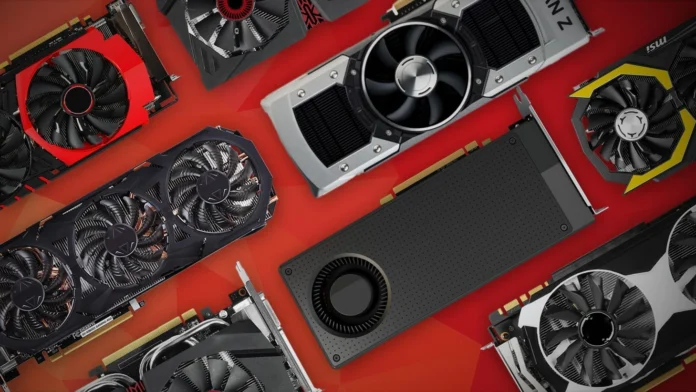How to choose a video card
Choosing a video card is not just buying another component for your computer, it is an investment in your gaming pleasure. To make the right choice, you should know the features and what to look for when buying. Important details to consider when choosing:
-
Performance: The number of stream processors, core frequency and video memory size play an important role. The higher these parameters, the smoother and more detailed the picture you will get.
-
Video memory: affects performance in games with high resolutions and textures. It is recommended to choose video cards with at least 8 GB of memory for modern games.
-
Interface: Make sure your motherboard supports the graphics card interface (PCIe 4.0 or PCIe 3.0). This will ensure maximum bandwidth and performance.
-
Power Consumption: GPUs consume a lot of power, so it’s important to consider the power of your power supply and the efficiency of your cooling system.
-
Additional features: models support ray tracing, DLSS, AMD FSR and other technologies that improve graphics quality and performance.
-
Price: The cost of video cards can vary significantly. Determine your budget and choose not the cheapest models, whose features offer the best price-performance ratio.
We present you the top 10 best graphics cards of 2025, taking a detailed look at their characteristics, advantages and disadvantages to help you make an informed choice.
1. ASRock Radeon RX 6600 Challenger D
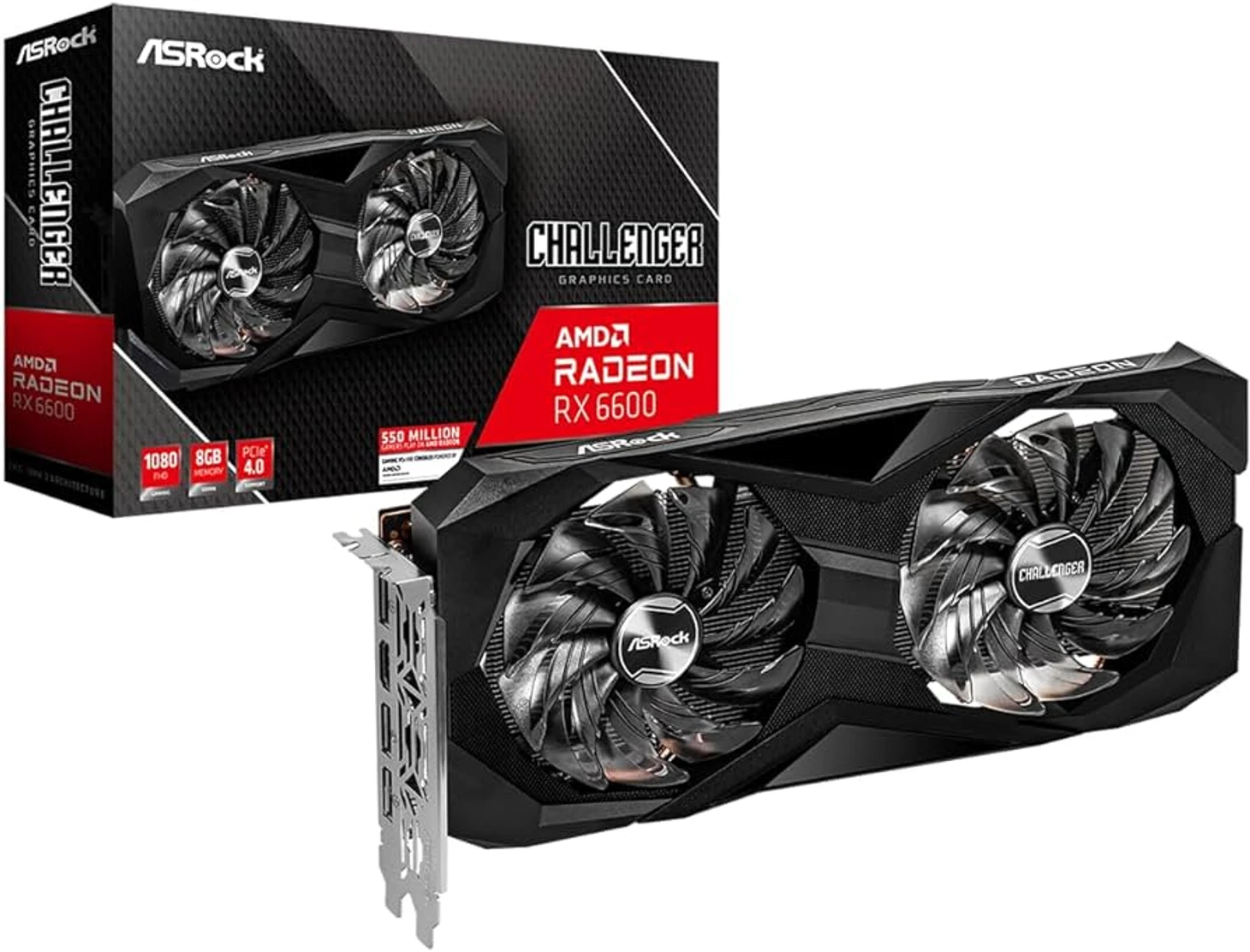
-
Manufacturer: ASRock;
-
Number of stream cores: 1792;
-
Core frequency: up to 2491 MHz;
-
Video memory: 8 GB GDDR6;
-
Memory frequency: 14000 MHz;
-
Memory bandwidth: 224 GB/s;
-
TGP: 132 W.
With 1792 stream processors and a core frequency reaching 2491 MHz in Boost mode, the Radeon RX 6600 Challenger D allows you to comfortably play modern games in Full HD resolution. You will be able to enjoy a smooth picture with a frame rate of 60 fps and above, and if necessary, reduce graphics settings to achieve even greater performance. 8 GB of GDDR6 video memory with a 128-bit bus and a frequency of 14000 MHz provide enough bandwidth for fast data processing, which is important in games with a large number of textures and effects.
At the same time, the card’s power consumption is only 135 W, which makes it economical and undemanding to the cooling system. One of the main features of the ASRock Radeon RX 6600 Challenger D is its efficient cooling system with two fans.
Advantages:
-
Excellent gaming performance at Full HD resolution.
-
Support for modern technologies such as AMD FSR and ray tracing.
-
Efficient and quiet cooling system.
-
Low power consumption.
-
Optimal price/performance ratio.
Flaws:
-
Limited video memory (8GB) may not be enough for some demanding games in the future.
-
Not the best performance at 1440p and above.
2. NVIDIA GeForce RTX 3050
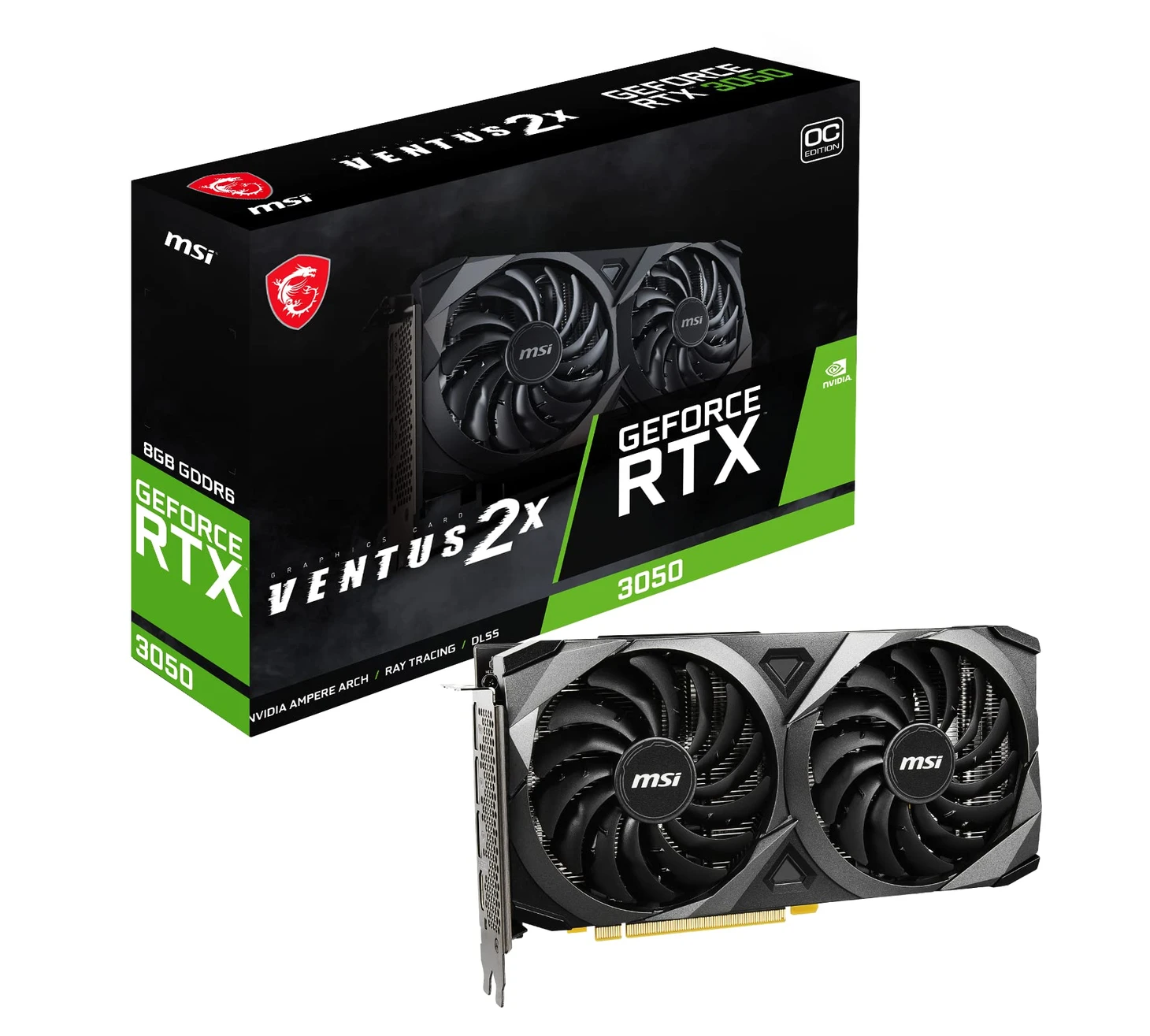
-
Manufacturer: NVIDIA;
-
Number of stream cores: 2048;
-
Core frequency: up to 1740 MHz;
-
Video memory: 4 GB GDDR6;
-
Memory frequency: 14 GHz;
-
Memory bandwidth: 128 GB/s;
-
TGP: 35-80 W.
An entry-level graphics card that is very popular among gamers due to its affordability and good performance at 1080p. Despite its compact size and effective cooling, it comes with 8 GB of video memory, which is excellent for its price segment. NVIDIA’s DLSS technology allows for significantly higher frame rates in games, improving visual perception and reducing image blur compared to AMD FSR. This makes the GeForce RTX 3050 a great choice for gamers who want to get the most out of their games without overpaying for more powerful models.
The GeForce RTX 3050 also supports ray tracing, allowing you to enjoy realistic lighting effects in games. While performance may be limited in ray tracing mode, it still opens up new possibilities for the visual experience of games.
Advantages:
-
Good performance at 1080p.
-
Support for ray tracing and DLSS for improved graphics quality.
-
Low power consumption and efficient cooling.
-
Affordable price.
-
8 GB of video memory is sufficient for most modern games.
Flaws:
-
Not suitable for 4K gaming.
-
Inferior to more powerful video cards in performance.
-
Limited overclocking capabilities.
3. MSI Intel Arc A750 Astro 2X
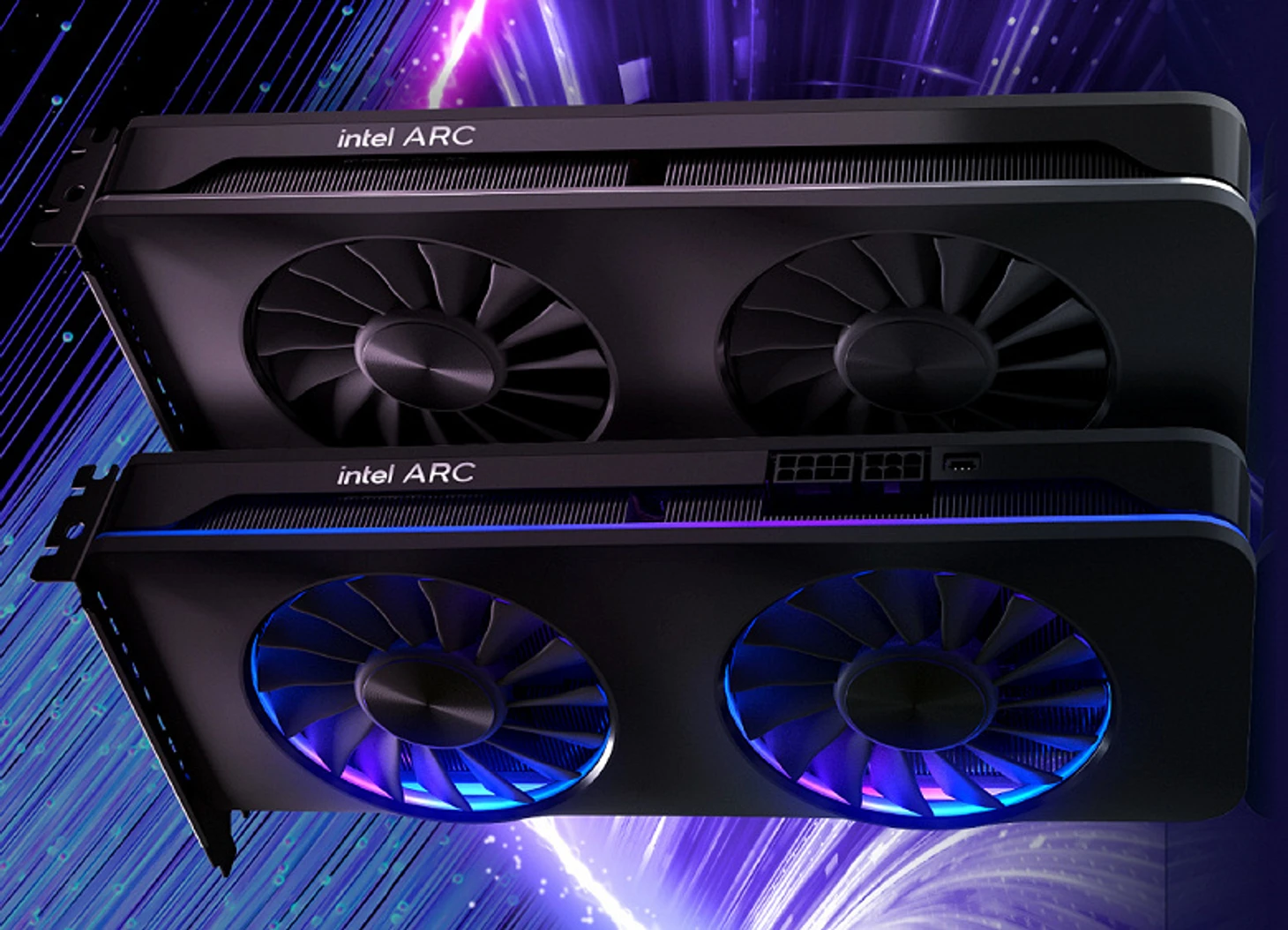
-
Manufacturer: MSI;
-
Number of stream cores: 28;
-
Core frequency: 2200 MHz;
-
Video memory: 8 GB GDDR6;
-
Memory frequency: 16 Gbps;
-
Memory bandwidth: 512 GB/s;
-
TGP: 225 W.
Despite the Arc architecture being different from Nvidia and AMD, the A750 delivers impressive performance comparable to the GeForce RTX 3060, but at a more attractive price. With 3,584 stream cores running at up to 2,400 MHz in Boost mode and 8GB of GDDR6 VRAM with a 256-bit bus, the A750 delivers smooth gameplay at 1080p and even 1440p. XeSS, Nvidia’s equivalent of DLSS, further improves performance and image quality.
MSI Intel Arc A750 Astro 2X also pleases with its quiet operation. An effective cooling system with two fans ensures low temperatures even under high loads, and the absence of annoying squealing chokes makes the gaming process even more comfortable.
Advantages:
-
Performance comparable to NVIDIA GeForce RTX 3060.
-
Supports XeSS technology to improve image quality.
-
Affordable price compared to competitors.
-
Quiet and efficient cooling system.
-
Large amount of video memory (8 GB).
Flaws:
-
Performance is inferior to top models from NVIDIA and AMD.
-
Does not support DLSS technology.
-
There may be optimization issues with some games, although Intel is actively working on improving drivers.
-
High power consumption (225W).
4. NVIDIA GeForce RTX 4060

-
Manufacturer: NVIDIA;
-
Number of stream cores: 3072;
-
Core frequency: 1830 MHz (Boost up to 2460 MHz);
-
Video memory: 8 GB GDDR6;
-
Memory frequency: 17 Gbps;
-
Memory bandwidth: 272 GB/s;
-
TGP: 115 W.
A mid-range graphics card that relies on DLSS 3 and Frame Generation technologies, as well as low power consumption. These features make it an attractive option for gamers who want to get the most out of their games at 1080p. Thanks to DLSS 3 and Frame Generation, the RTX 4060 is capable of significantly increasing the frame rate of games, especially those that support ray tracing. This allows you to enjoy smooth gameplay and high image detail even on mid-range systems.
However, despite being a 40-series card, the performance gains over its predecessor, the GeForce RTX 3060, are not as impressive. This is because the RTX 4060 uses a cut-down version of the AD107 GPU with fewer CUDA cores and less memory bandwidth.
Advantages:
-
Supports DLSS 3 and Frame Generation, significantly improving gaming performance.
-
Low power consumption and quiet operation.
-
Affordable price compared to more powerful models.
-
Compact size fits most cases.
Flaws:
-
Slight performance gain over RTX 3060 without DLSS enabled.
-
Limited video memory (8 GB).
-
Not suitable for 4K gaming with maximum graphics settings.
-
Raw performance (without DLSS) may not satisfy some users.
5. Palit GeForce RTX 4070 Ti JetStream

-
Manufacturer: Palit;
-
Number of stream cores: 7680;
-
Core frequency: 2310 MHz (base) / 2610 MHz (Boost);
-
Video memory: 12 GB GDDR6X;
-
Memory frequency: 21000 MHz (effective);
-
Memory bandwidth: 504 GB/s;
-
TGP: 285 W.
With 7680 CUDA cores running at up to 2610 MHz in Boost mode and 12 GB of ultra-fast GDDR6X video memory, the card guarantees excellent gameplay in 4K resolution with high graphics settings. NVIDIA DLSS 3, Ray Tracing and Reflex technologies make the image incredibly realistic and responsive, immersing you in the game world like never before. JetStream cooling deserves a special mention. Thanks to a powerful radiator and three fans, the graphics card stays cool even under maximum loads. At the same time, the fans do not turn on until the temperature reaches 50 degrees Celsius, ensuring silent operation in idle mode and when performing undemanding tasks.
Advantages:
-
High performance in modern games.
-
Supports advanced NVIDIA DLSS 3, Ray Tracing and Reflex technologies.
-
Possibility of modification without loss of warranty.
-
Quiet and efficient cooling system.
-
High overclocking potential.
Flaws:
-
High price.
-
Requires a powerful power supply.
-
The large size can be a problem for compact cases.
6. AMD Radeon RX 7800 XT

-
Manufacturer: AMD;
-
Number of stream cores: 6144;
-
Core frequency: up to 2565 MHz (Boost);
-
Video memory: 16 GB GDDR6;
-
Memory frequency: 19.5 Gbps;
-
Memory bandwidth: 624 GB/s;
-
TGP: 263 W.
The AMD Radeon RX 7800 XT is AMD’s flagship graphics card that takes on the GeForce RTX 4070 Ti at 1440p, a popular resolution among gamers. With RDNA 3 architecture and 16GB of GDDR6 memory, it delivers smooth gameplay and high image detail.
The Radeon RX 7800 XT also excels in ray-traced games, beating the GeForce RTX 4070 Ti at QHD (2560×1440) by a whopping 20%. AMD FSR 2.1 technology further improves image quality and performance in supported games.
Advantages:
-
High performance at 1440p and above.
-
Supports ray tracing and AMD FSR 2.1 technology for improved image quality.
-
Affordable price compared to competitors.
-
Efficient cooling system.
Flaws:
-
High power consumption under load.
-
Does not support NVIDIA’s DLSS technology.
-
Power supply upgrade may be required to ensure stable operation.
7. Palit GeForce RTX 4080 JetStream

-
Manufacturer: Palit;
-
Number of stream cores: 9728;
-
Core Clock: 2205 MHz (Boost Clock up to 2505 MHz);
-
Video memory: 16 GB GDDR6X;
-
Memory frequency: 22.4 Gbps;
-
Memory Bandwidth: 716.8 GB/s;
-
TGP: 320 W.
Palit GeForce RTX 4080 JetStream is not just a graphics card, it is a pass to the world of top graphics. This model with Ada Lovelace architecture and DLSS 3 support is ready to squeeze the maximum out of any game, providing smooth gameplay and stunning detail even in 4K. The JetStream cooling system with three fans ensures that your RTX 4080 will remain cool even under maximum load, and the stylish design with RGB lighting will add charm to your system unit.
If you are looking for a graphics card that will not let you down in the most demanding games and will allow you to enjoy the next-generation graphics, Palit GeForce RTX 4080 JetStream is your choice. With it, you can forget about lags and slowdowns, and the graphics will become the main weapon in virtual worlds. This powerful graphics card easily handles games in 4K and 144 Hz on ultra settings. Thanks to the advanced 4nm chip with 45.9 billion transistors, it even surpasses the RTX 3090 Ti. JetStream provides quiet and efficient operation, consuming no more than 290 watts.
Pros:
-
Highest performance.
-
Supports ray tracing and DLSS 3.0.
-
Energy efficient and quiet operation.
-
Discreet design.
-
More affordable than other flagships.
Cons:
-
Large size and weight.
-
Limited availability.
-
High price for the middle segment.
8. Palit GeForce RTX 4090 GameRock OC
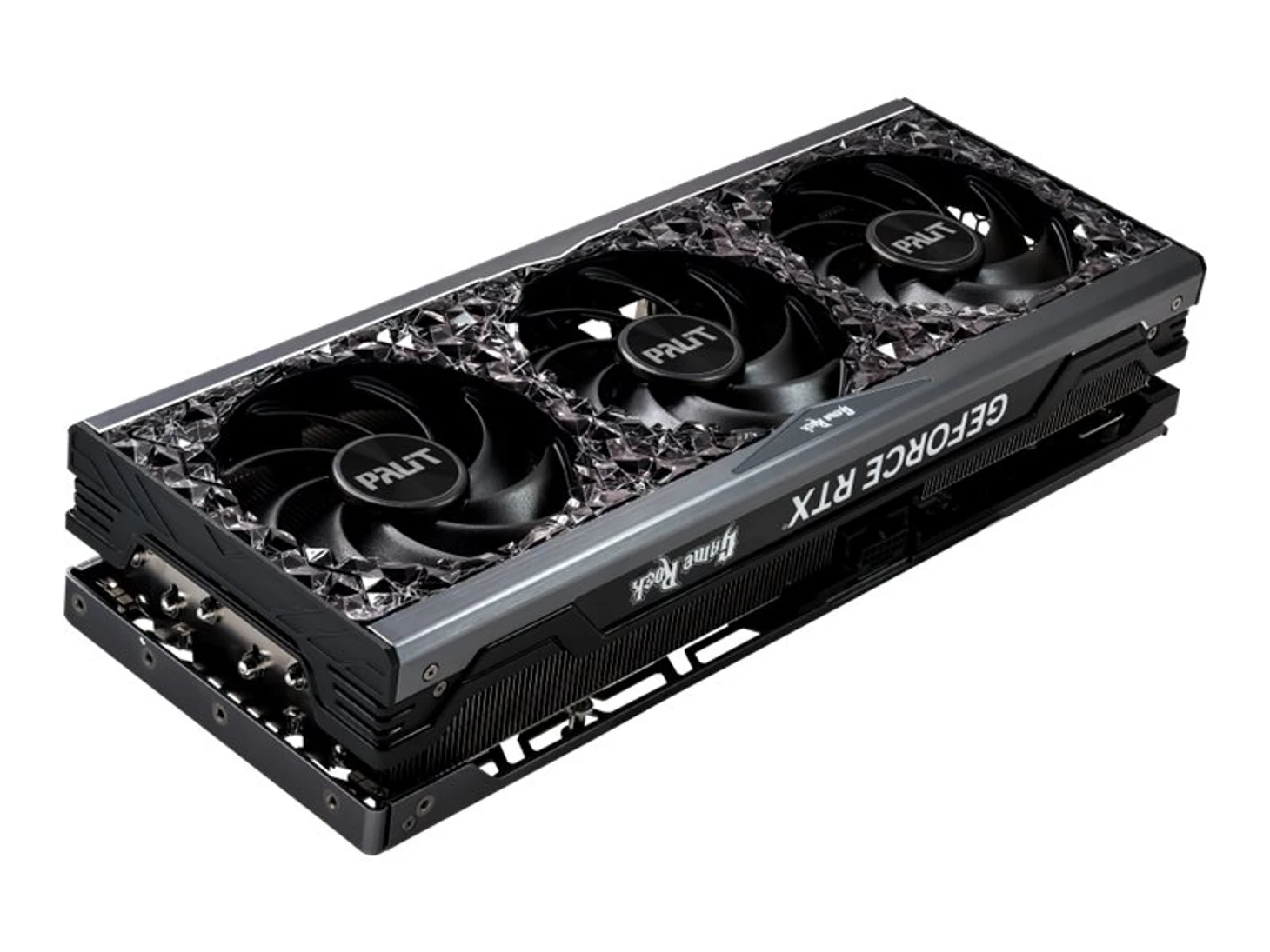
-
Manufacturer: Palit;
-
Number of stream cores: 16384;
-
Core frequency: 2235 MHz (Base) / 2520 MHz (Boost);
-
Video memory: 24 GB GDDR6X;
-
Memory frequency: 21000 MHz;
-
Memory bandwidth: 1008 GB/s;
-
TGP: 450 W.
Palit GeForce RTX 4090 GameRock OC is a real performance monster that will take your gaming experience to the next level. This card is an absolute top, capable of delivering incredible graphics in any games, even at maximum settings and 4K resolution. Gale Hunter Fan and Y Formula Fins cooling guarantee stable operation even under maximum load, and the Starlight Black crystal design with ARGB backlighting will turn your system unit into a real work of art.
Palit GeForce RTX 4090 GameRock OC is the choice of true enthusiasts who are not ready to compromise and want to get the most out of their games. If you dream of top-end graphics and smooth gameplay, then this video card is made for you. Performance in 4K and 8K with ray tracing and DLSS 3.0. 16384 CUDA cores and 24 GB GDDR6X provide an unrivaled gaming experience.
Pros:
-
Top performance in games and applications.
-
Support for the latest technologies.
-
Efficient and quiet cooling.
-
High quality and reliability.
-
4x 8-pin connectors for stability.
Cons:
-
Very high price.
-
High power consumption.
-
A powerful power supply is required.
-
Large size.
9. NVIDIA GeForce RTX 4080 Founders Edition
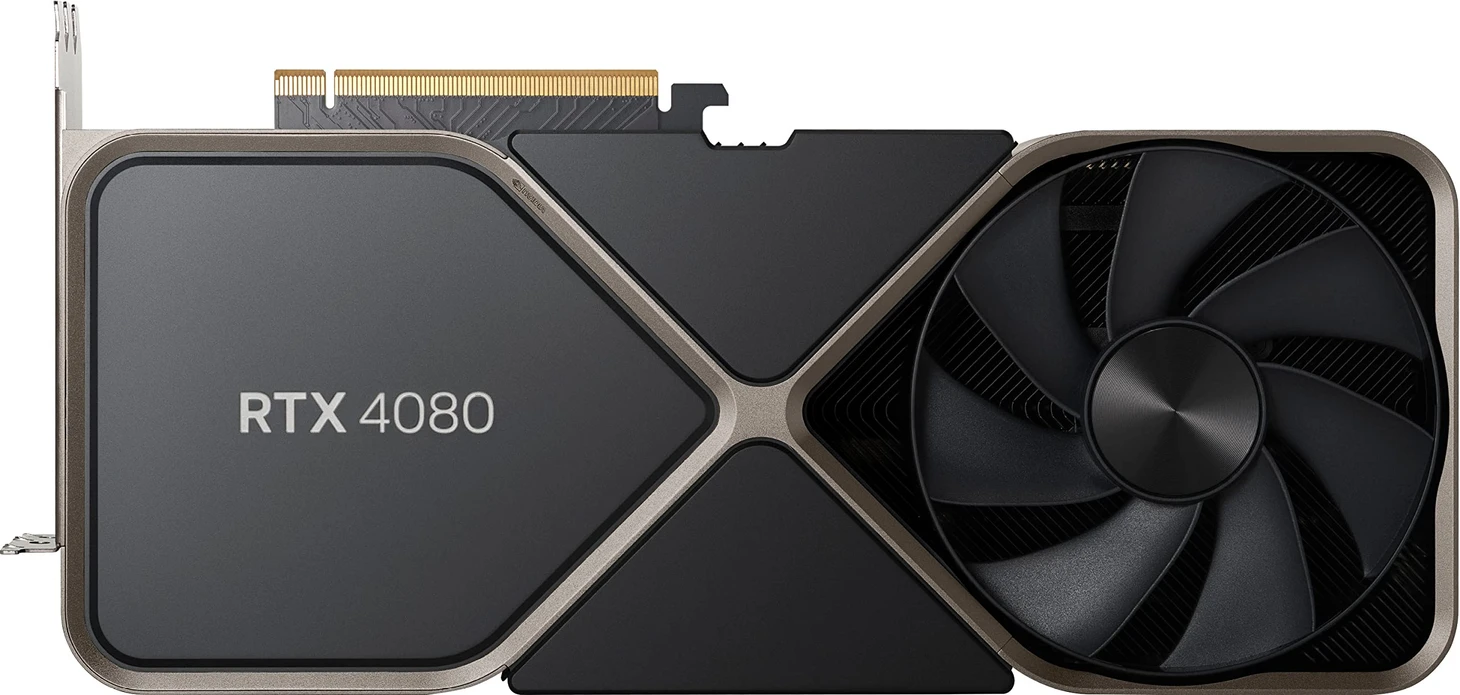
-
Manufacturer: NVIDIA;
-
Number of stream cores: 9728;
-
Core frequency: 2205 MHz (Base) / 2505 MHz (Boost);
-
Video memory: 16 GB GDDR6X;
-
Memory frequency: 22.4 Gbps;
-
Memory Bandwidth: 716.8 GB/s;
-
TGP: 320 W.
The GeForce RTX 4080 Founders Edition is a reference graphics card from NVIDIA that features a strict design and an effective cooling system. It delivers excellent performance at 4K resolution, allowing you to enjoy realistic graphics.
This powerful graphics card based on the Ada Lovelace architecture delivers incredible graphics in 4K resolution and high graphics settings, making games as realistic and immersive as possible. DLSS 3.0 technology takes performance to new heights, allowing you to enjoy smooth gameplay even in the most demanding games. And thanks to second-generation ray tracing, lighting, shadows, and reflections in games look so realistic that it is sometimes difficult to distinguish the virtual world from reality.
Advantages:
-
High performance in modern games.
-
Support for advanced ray tracing technologies and DLSS 3.0.
-
Efficient cooling system with two fans.
-
Strict and elegant design.
Flaws:
-
High price.
-
Requires a powerful power supply.
-
Limited overclocking potential compared to other models.
10. ASUS ROG Strix Radeon RX 7900 XTX OC Edition

-
Manufacturer: ASUS;
-
Number of stream cores: 6144;
-
Core frequency: up to 2680 MHz (Boost Clock);
-
Video memory: 24 GB GDDR6;
-
Memory frequency: 20 Gbps;
-
Memory bandwidth: 960 GB/s;
-
TGP: 355 W.
The ASUS ROG Strix Radeon RX 7900 XTX OC Edition is a powerful graphics card from ASUS that features high performance, an effective cooling system, and a stylish design. It is ideal for gamers who want to get the most out of their games in 4K and even 8K resolution. This card is designed for those who are not ready to compromise and crave maximum performance.
The heart of this beauty is a powerful AMD Radeon RX 7900 XTX graphics processor with 6144 stream processors, operating at a frequency of up to 2680 MHz. In combination with 24 GB of GDDR6 video memory and a bandwidth of 960 GB / s, this card provides incredibly smooth and detailed graphics in any games, even at the highest settings. But the ASUS ROG Strix Radeon RX 7900 XTX OC Edition is not only power, but also style. The unique design with Aura Sync RGB lighting and a massive cooling system not only looks spectacular, but also guarantees stable operation even under maximum loads.
Advantages:
-
High performance in games.
-
Supports ray tracing and AMD FSR 2.0.
-
Efficient cooling system with three fans.
-
Stylish design with RGB backlight.
-
High overclocking potential.
Flaws:
-
Very high price.
-
Large size.
-
High power consumption.
Conclusion
For 1440p gaming, you should consider the RTX 4070 or RX 6700 XT. And if you want to enjoy 4K gaming with maximum graphics settings, then your choice is the RTX 4080, RTX 4090, or RX 7900 XTX. Ultimately, the best graphics card is the one that suits your individual needs and allows you to enjoy gaming to the fullest. We hope our list of the best graphics cards will help you make the right choice and find the perfect graphics card for your gaming PC.

